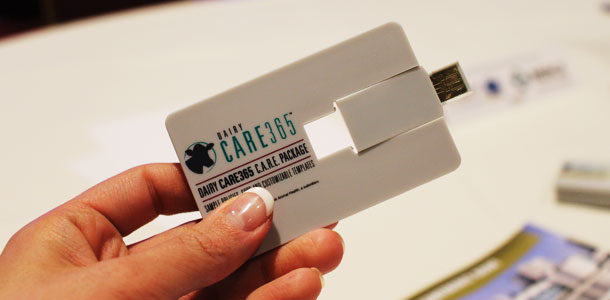“In an instant, our 100-plus-year-old family farm became part of the re-branding of agriculture by activist groups. We lost our milk market and our reputation was tarnished.” —Gary Conklin, Conklin Dairy Cattle Sales LLC. In May of 2010, a video from his farm depicting abuse was released by Mercy for Animals. Preparing for emergencies and managing crises was a main focus of the Dairy Strong conference, Jan. 13-15, in Madison, Wisconsin, facilitated by the Dairy Business Association of Wisconsin and its partners. I’m a member of the organization, but this was my first time attending one of their conferences.
After seeing a few ads in my local farm papers, I decided to check out the schedule online. This was not just another ag conference. In addition to candid sessions about activist attacks and public perception of the dairy industry, the schedule featured sessions about mobile technology and the dairy economy.
One of the sessions I was most excited to attend was the Merck Animal Health Dairy Care365 workshop. This three-hour session focused on helping participants create emergency preparedness tools tailored to their farms.

Full disclosure: Our farm does not have a crisis management plan, a formal core response team or a phone tree. Heck, we don’t even have a single documented standard operating procedure (or SOP). Before you write me off as a member of the Clampett family, I should tell you that my husband Nick and I only milk 60 cows. Since we don’t have any employees, we have never taken the time to document an emergency plan.
Nick and I participate in the National Dairy FARM Program – Farmers Assuring Responsible Management – and after our last audit, the one criticism they had for us was our lack of SOPs. I’m a communicator by trade, but it’s hard to find the time to create these documents for our farm, especially when we may never use them.
But I don’t like unfinished business, and more than anything, I don’t want to manage our farm differently because it’s small.
The workshop promised to provide SOP templates and outlines for an emergency preparedness plan. Free templates? No judgment for changing a few words and using their language for SOPs? I was in.

We started the session with an overview of the take-home items: A flash drive fully loaded with English and Spanish SOP and planning templates, a workbook outlining why and how a farm should prepare for emergencies, and finally we viewed a few video training modules that showcased proper techniques in challenging situations on the farm – such as downed (or non-ambulatory) cows.
The workshop is intended to be a full-day training session, so the speakers had to move quickly through the modules.
Representatives spoke about talking with the media and the importance of developing key messages about your farm. They even included tools on the flash drive about how to craft these messages and where to talk to media if you were asked for an interview.
One of my favorite aspects of the workshop was the video training module. I think I’ve only seen maybe one or two non-ambulatory cows on our farm, and the video explaining the methods for moving a cow that can’t stand and walk gave me a better understanding of our options given the layout of our farm.

Every farm has unique needs in terms of emergency preparedness. For me, the greatest value in attending the workshop was the SOP and emergency preparedness planning templates. We might not be a high-risk target for an animal activist group, but there are other emergencies such as accidents or natural disasters that can happen to farms of all sizes. The templates from the workshop are exactly what I need to get started.
Our farm is small, and as dairy farmers, the size of our farms shouldn’t really matter – we are all part of the dairy industry. If we implement the tools presented in the Dairy Care365 program and talk to our friends and neighbors who might need it more than we do, it could catch on and start to make a real difference. PD
Maria F. McGinnis is a freelance writer. She and her husband, Nick Woldt, are first-generation farmers milking 60 cows in Sun Prairie, Wisconsin.
PHOTOS
PHOTO 1: Participants in the MERCK Dairy Care365 were given flash drives loaded with SOP examples in English and Spanish as well as templates for crisis planning.
PHOTO 2: Maria McGinnis found value in the workshop’s SOP and emergency preparedness planning templates.
PHOTO 3: This template illustrates who might be included in a farm’s core response team. Simply drop in your contacts and their phone numbers.
PHOTO 4: In addition to electronic copies of templates, participants got to take home a spiral bound workbook. Photos courtesy Maria F. McGinnis.



